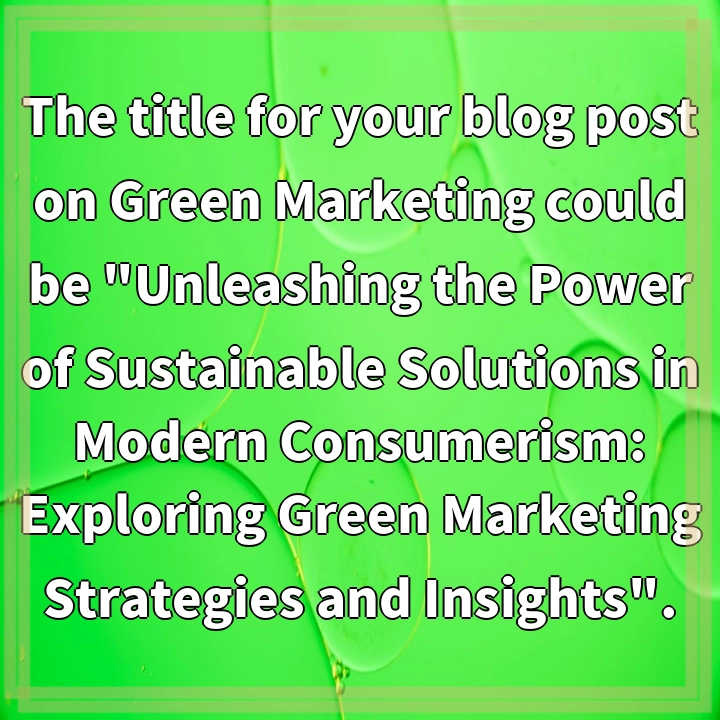
What is Green Marketing?
Green marketing, also known as sustainable marketing or eco-marketing, is a business strategy that focuses on promoting environmentally friendly products, services, and practices. It involves integrating sustainability principles into various aspects of marketing, including product development, advertising, packaging, and corporate messaging.
Real-World Problems Associated with Green Marketing
1. Greenwashing
One of the major challenges in green marketing is greenwashing. Greenwashing refers to the deceptive marketing tactics employed by some companies to make their products or practices appear more environmentally friendly than they actually are. This misleading branding can lead consumers to make misguided purchasing decisions, undermining the credibility of genuinely eco-friendly products.
2. Miscommunication and Confusion
Green marketing often involves complex concepts and terminology, which can lead to miscommunication and confusion. Consumers may struggle to understand the true environmental impact of a product or service due to vague or inconsistent green marketing claims. This lack of clarity can make it challenging for consumers to make informed decisions and support genuinely sustainable options.
3. Lack of Regulation and Standards
Another issue faced by green marketing initiatives is the absence of standardized regulations and certifications. The lack of clear guidelines or industry standards makes it difficult for consumers to differentiate between genuinely eco-friendly products and those that make false or exaggerated environmental claims. This creates a need for stronger regulations and certifications to ensure transparency and protect consumers.
4. Consumer Skepticism
Due to the prevalence of greenwashing and inconsistent messaging, consumers have become increasingly skeptical of green marketing claims. Many consumers are now more cautious when evaluating environmental claims made by companies and are demanding greater transparency and authenticity. Building trust and credibility is a significant challenge for companies seeking to engage in green marketing.
5. Limited Awareness and Education
While awareness of environmental issues has increased in recent years, there is still a lack of widespread understanding about the true implications of sustainable practices and the importance of supporting genuinely green products. Limited awareness and education hinder the success of green marketing initiatives, requiring companies to invest in consumer education and engagement to drive behavior change.
6. Cost and Implementation Challenges
Implementing green marketing strategies often requires significant investment and operational changes. Companies may face higher production costs in sourcing sustainable materials, implementing eco-friendly processes, or redesigning products and packaging. These cost implications can pose challenges, particularly for small businesses or those operating in price-sensitive markets.
In conclusion, while green marketing holds great potential in promoting sustainable consumerism, it is not without its challenges. Overcoming issues such as greenwashing, miscommunication, lack of regulation, consumer skepticism, limited awareness, and implementation challenges is crucial for the success of green marketing initiatives and the overall shift towards a more sustainable future.

Solutions to Real-World Problems in Green Marketing
1. Enhance Transparency and Regulation
A key solution to combat greenwashing and miscommunication is to establish stricter regulations and industry standards for green marketing claims. Clear guidelines and certifications can help consumers identify authentic eco-friendly products and hold companies accountable for their environmental claims.
2. Improve Consumer Education
Investing in consumer education and awareness campaigns can help bridge the gap in understanding about sustainable practices and the importance of supporting genuinely green products. Providing clear and accessible information can empower consumers to make informed choices and actively participate in sustainable consumerism.
3. Foster Collaboration and Partnerships
Collaborative efforts between businesses, governments, and NGOs can drive the adoption of sustainable practices and amplify the impact of green marketing initiatives. Partnerships can facilitate knowledge sharing, resource pooling, and the development of innovative solutions to address environmental challenges.
4. Prioritize Authenticity and Credibility
Companies should prioritize authenticity and credibility in their green marketing efforts to build consumer trust. This can be achieved through transparent communication, honest messaging, and providing verifiable evidence of sustainable practices.
5. Embrace Circular Economy Principles
Shifting towards a circular economy, where resources are used more efficiently and waste is minimized, can align with green marketing strategies. Emphasizing product durability, recyclability, and offering take-back programs can showcase a commitment to sustainability and differentiate brands in the market.
6. Innovate and Invest in Research
Continued research and innovation in sustainable technologies and practices can drive the development of greener products and services. Investing in research and development can not only improve environmental performance but also create opportunities for market differentiation and competitive advantages.
By implementing these solutions, companies and stakeholders can overcome the real-world problems associated with green marketing and contribute to a more sustainable and responsible consumer culture.















